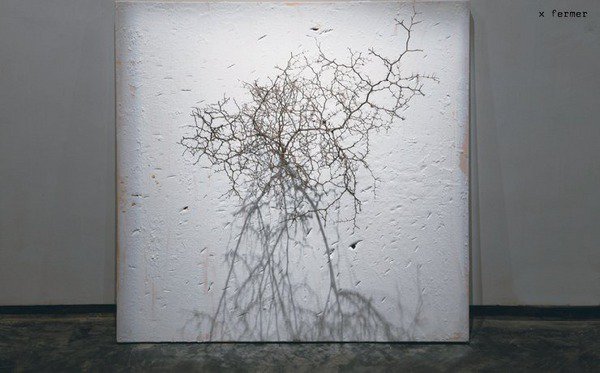(M)other India
dal 15/9/2011 al 28/10/2011
Segnalato da
Acharya Vyakul
T. Venkana
Shine Shivan
Aaditi Joshi
Priyanka Choudary
Prashant Pandey
Sanjeev Khandekar
Jivya Soma Mashe
Chano Devi
Bhuri Bai
Andre' Magnin
Andre' Jamme
Abhay Maskara
Herve' Perdriolle
15/9/2011
(M)other India
Galerie du Jour Agnes B., Paris
Another India. And, above all, another way of looking at contemporary Indian art, a way that is on the margins of convention - always there, in whatever era, to blur the picture. A group show displayed in three sections. Among the artists: Acharya Vyakul, Jivya Soma Mashe, Venkana, Shine Shivan, Aaditi Joshi, Priyanka Choudary and Prashant Pandey.

Travel constantly increases our understanding that it is People who glorify places and the greatest “glo-
rifiers” are always the artists who make things new again, so that we are able to see them with fresh
eyes. From the most far-flung villages, in any culture, it is always the artists who reach out with their
creative power, their power of protest...
(M)other India. Another India. And, above all, another way of looking at contemporary Indian art, a way
that is on the margins of convention – always there, in whatever era, to blur the picture.
There are three major sections to this (M)other India.
First, the Indian artists who have already exhibited in the past at the galerie du Jour: Vyakul in 1993,
Tantra in 1995 and Korwa in 1997, all of them shown again in 2005 at the Ecole Nationale Supérieure
des Beaux-Arts. Three exhibitions mounted by the writer and poet Franck André Jamme.
Acharya Vyakul, a great primitive and eccentric painter whose work was shaped by popular art and
Tantrism, died in 2000. But in 1989 he was one of the “stars” of Magiciens de la Terre at the Pompidou
Centre. It was the first exhibition of his life. An artist equally at home with abstract and figurative art,
working “when the fancy took him”, he was within ten years an international figure, with pictures in a
large number of private collections.
The abstract Tantric paintings from Rajasthan, primarily aids to meditation, are wonders of form and
colour. Luminous, simple and extraordinarily present, they too formed part of the Magiciens de la Terre
exhibition and later conquered art lovers across the Atlantic, especially at the Drawing Center in New
York in 2004.
Also present are the “magic writings” of the Hill Korwa tribe, in the centre of India – women and men
whose dream was always, determinedly, to write. They were visited three or four times in twenty years by
various researchers, and they would spontaneously seize hold of the brushes and pencils offered them,
each time creating unforgettable texts, beautifully set out on the page and made up of totally imaginary
alphabets. These rarities also had their moment of glory at the Drawing Center in 2000.
The second section of (M)other India involves some major works by the “other Indian masters”: the tribal
populations, the adivasis (literally the “early inhabitants”) of the Indian subcontinent. These rare large
formats were created on the initiative of Hervé Perdriolle, who has been collecting these artists since
1996. Among the works are paintings by Jivya Soma Mashe, the legendary artist of the Warli tribe,
already exhibited by Magiciens de la Terre, then again very recently at the exhibition Autre Maîtres de
l’Inde at the Quai Branly museum. There are also works by Chano Devi, who introduced the “Godana
Painting” style to the Bihar, a style now practised by many women. Last but not least, there is the re-
nowned Bhuri Bai, from the Bill tribe.
The third panel of our triptych, presented for the first time in France, features one of the emerging sce-
nes in contemporary Indian art, centred around the Gallery Maskara in Mumbai. Five young artists will
thus be honoured by (M)other India: T. Venkana, Shine Shivan, Aaditi Joshi, Priyanka Choudary and
Prashant Pandey. For all of them, the body is omnipresent, a body that is certainly inhibited by often
cumbersome family and social structures, but now suddenly finding expression through sex, blood and
urine. The body: animate matter. Matter: sensitive body. And there is still a final guest, who stands on his
own, the always slightly scandalous Sanjeev Khandekar, who amazes us with his subtle and delicate
Sick Paintings. It is hard to believe they were in fact painted with “fresh vomit” – the body, once again.
That’s it.
The common feature of looking at all these pieces, and also the common feature linking all of them,
running through them, is perhaps simply a deep jubilation at diversity, at the powerful and delightful ri-
chness of that diversity.
But India, after all, is like that.
(Franck André Jamme is the author of the title (M)other India, the exhibition for this autumn 2011)
Image: Priyanka Choudary, Untitled, 2010
Galerie du Jour Agnès B.
44 rue Quincampoix - Paris
Hours: tue-sat 12-7pm



